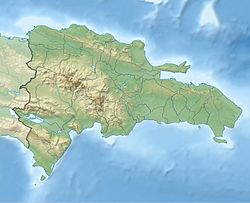Lago de Oviedo facts for kids
Quick facts for kids Lago de Oviedo |
|
|---|---|
| Laguna de Oviedo | |
 |
|
| Location | Jaragua National Park, Pedernales Province |
| Coordinates | 17°45′33″N 71°21′59″W / 17.75915°N 71.366501°W |
| Type | saltwater lake |
| Basin countries | |
Lago de Oviedo, also known as Laguna de Oviedo, is a special saltwater lake located in the Jaragua National Park. You can find it in the Pedernales Province of the Dominican Republic. It's a unique natural spot, famous for its interesting wildlife and salty water.
How Big is Lago de Oviedo?
Lago de Oviedo is quite large! It covers about 25 square kilometers (that's 25,000,000 square meters). This makes it the second biggest body of water in the Dominican Republic. Only Lake Enriquillo is larger.
Why is the Water Salty?
Even though the lake gets fresh water from the nearby Bahoruco Mountain Range, it's still very salty. This is because sea water flows into the lake through underground passages. These passages are part of a special type of land called a karstic depression. This means the ground has holes and caves that allow water to move through.
The amount of salt in the lake changes throughout the year. It depends on how much rain falls and how much water evaporates. The lake's water often looks greenish. This color comes from tiny bits of limestone that are carried into the lake by the underground water.
Amazing Animals and Plants
The plants and animals living around Lago de Oviedo are truly special. The lake is known for its unique ecosystem, which means all the living things and their environment.
- Mangroves: These are special trees that grow in salty water. Their roots help protect the shoreline and provide homes for many creatures.
- American Flamingos: You can often see beautiful pink American flamingos wading in the shallow waters. They feed on tiny organisms in the lake.
- Rhinoceros Iguanas: These large lizards are native to the island. They have horn-like growths on their snouts, which makes them look like small rhinos!
- Endemic Birds: Many different kinds of birds live here. Some of them are endemic, meaning they are found only in this area and nowhere else in the world.
- Islands: The lake has several small islands, called cays. These islands are important nesting sites for many birds and other animals.
Learn More
- In Spanish: Laguna de Oviedo para niños


